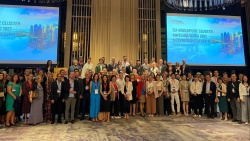On the 3 October 2019, secpho has organized the first sectoral workshop of the European programme DIGI-B-CUBE at the Hospital Germans Trias i Pujol (HGTP) in Badalona (Spain). The hospital recently made a commitment to open innovation and within this strategy, one of the first steps has been opening its doors to get to know how new digital technologies can revolutionize the health sector in the 21st century.
The Hospital Germans Trias i Pujol, member of the Open Innovation Club by secpho, and the Germans Trias i Pujol Research Institute (IGTP) have been developing this joint innovation programme for months, aimed at connecting doctors and researchers from health research institutes with experts in photonics in order to set up entrepreneurial projects.
In that sense, we brought together 55 professionals from medical, IT and other sectors to gain a common understanding of the general medical diagnostics value chain, it’s technological challenges and the capabilities of light-based technologies, with the final objective to tackle digitalisation challenges within the health sector, across the Bioimaging, Biosensing and Biobanking industries.
After opening the session, Dr. Oriol Estrada, Director of Innovation and Transversal Processes of the Northern Metropolitan Territorial Management of ICS, took over from Dr. Daniel Moreno, Head of Innovation, who explained how this new line of activity fits into the strategy of the Hospital initiated in recent months.
Afterwards, Sergio Sáez, cluster manager at secpho, gave an overview of how photonics could have a positive impact on the healthcare sector and presented DIGI-B-CUBE, as new financing programme with a non-refundable grant of €2.7 million to promote the projects that arise from this collaboration. That was followed by expert pitches presenting different examples as a sample of the enormous possibilities of photonics in the health sector by 6 of secpho’s member companies and RTO’s, such as Hamamatsu, FYLA, Impetux, ICFO, Ledmotive and Eurecat. In particular the presented topics were:
- A photonics company vs. a medical instrumentation company that uses photonics | David Castrillo, Hamamatsu Photonics
- 3 moments of use: White laser in the healthcare field | Ismael Almazán, FYLA
- Optical tweezers in biomedical research | Oriol Nós, Impetux
- Photonic technologies for the study of disease development and the monitoring of its treatment | Martina Giovannella, ICFO
- Challenges of photonics technology | Josep Maria Serres, eurecat
- Spectral control of light. New applications for the care and service of people in healthcare settings | Pablo Garzón, ledmotive
- CMOS image sensors for medicine and biology | Renato Turchetta, IMASENIC Advanced Imaging S.L.
Also participating in the session was Rosa Sánchez, chief editor of the technological magazine light!, a magazine of reference in technological innovation, whose next two issues will focus on the applications of photonic research and technology in the healthcare field.
At the end, there were networking dynamics to connect new technologies with the health value chain. The aim of the workshop was to generate synergies between health professionals and researchers with companies in the health industry and photonics professionals, in order to create new perspectives to research projects and, together with the health approach, provide comprehensive and competitive solutions in the health market.
As follow up of the workshop specific innovation challenges will be indentified and collected, since those will be the focus of the upcoming cross-sectoral workshop foreseen in the beginning of December to create collaborative innovation projects.
All in all, this workshop is considered to be part of secpho’s open innovation programme for hospitals. During October 2019, two workshops in hospitals were organized, which up to now resulted in the identification of 7 innovation challenges and a few potential project consortia were initiated:
- Post-biopsy marking clip for follow-up and identification in surgery and pathology
- Tumor bed localization after breast cancer surgery for radiotherapy planning
- Determination of the actual breast volume and resection volume needed to plan breast cancer surgery
- Definition, during surgery, of the correct plane of separation between the breast and subcutaneous tissue to preserve its vascularization and avoid complications
- Photoactivable molecules capable of eliminating cancer stem cells with space-time precision
- Transcutaneous monitoring of biochemical parameters in premature infants
- Diagnostic device for the detection of plasmodium sp infection- D3PI
Stay tuned about the following challenges from the cross-sectoral workshop in the beginning of December. In the meantime, check out our upcoming DIGI-B-CUBE events and apply for the available travel vouchers.



